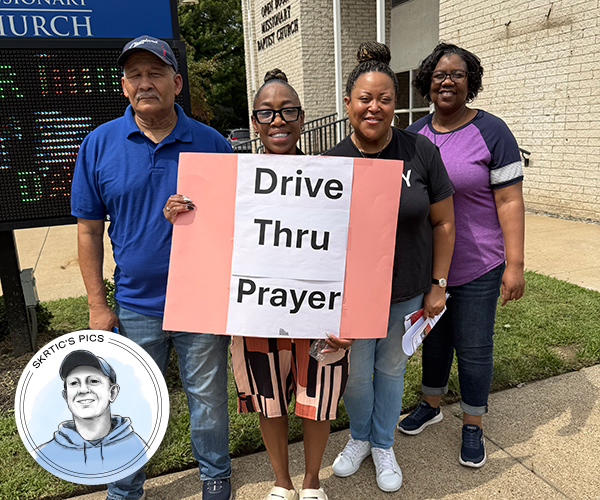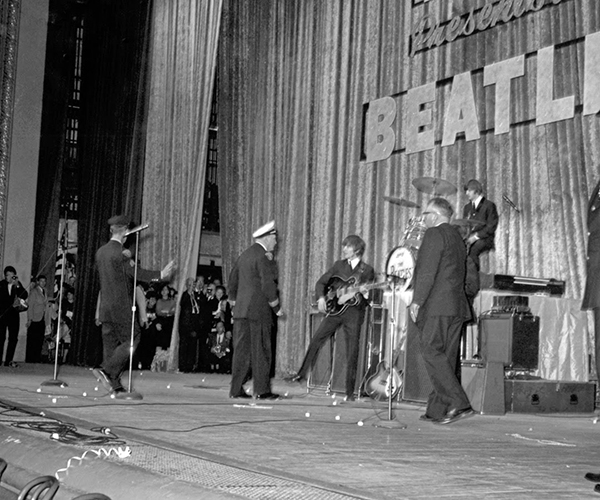"I'm going to the Western Country, bound for Oh-hi-O..."
As professional musicians play the fiddle and spoons, the fourth-graders at Cleveland's Forest Hill Parkway Academy belt out the first track of the song on their own CD, "Rails, Trails, Sails and Canals."
The CD, which the kids made in spring 2004, includes seven songs they wrote themselves with the musicians, who set the kids' words to blues and jazz beats. It tells the history of Cleveland through music — from the city's founding by Moses Cleaveland in 1796 to the energetic "We Love Cleveland," a tribute to the beginnings of the steel industry here.
The kids' musical lesson in Cleveland history came thanks to Kevin Richards, who launched his own nonprofit organization, Roots of American Music, in 1999.
"I was a music nut who loved American history," says Richards, who also owns the Fairmount School of Music in Cleveland Heights. "I thought it was really cool to expose children to songs with a social message or historical message. It's blossomed from there."
Now, Roots of American Music has an expansive portfolio of presentations, including lessons on Lewis and Clark, Ohio's bicentennial and the social changes of the 1960s, which it presents at elementary-, middle- and high-school assemblies. The organization also teaches history through music to smaller classes. It mostly works in Ohio, but as word has spread, it's visited other states, including North Carolina, Pennsylvania and Illinois.
Most schools pay a fee for the services, but Richards also finds grant money to bring his program to schools that otherwise couldn't afford it. That was one of the biggest reasons he made his organization nonprofit.
But it wasn't easy for Richards to shift from running the for-profit Fairmount School into the nonprofit world.
"It's very clear in the for-profit sector: Is this making money or not?" Richards says. "In the nonprofit sector, you just know going out the gate that there's not going to be a ton of money. Then, you've got to figure out how to get those charitable contributions to make things go."
That's just one of the steps for setting up a nonprofit. It took Richards more than a year to bring his dream to fruition.
"You've got to be nuts. You've got to be passionate," he says. "You've got to be very hard-working and dedicated. You have to be organized. You have to have a lot of energy. And you have to know a lot of people."
Knowing people in key positions helped Richards with one of the key components of starting a nonprofit: organizing a diverse board of directors.
"An early board has to be a hands-on board," says KC Henry-Bergman, a nonprofit consultant based in Chagrin Falls. Board members need to be prepared to work hard for the organization before it can afford to hire a paid staff.
To get that "hands-on" work, Richards made sure he chose people with skills he didn't have. "Professional experts in their fields — from attorneys to accounting people, presidents of law firms to presidents of companies," he says, adding that his board needed the three W's of nonprofit boards: worth, wealth and wisdom.
Before you choose a board, though, you need to do a lot of planning, says Ann Lucas, director of professional development at Case Western Reserve University's Mandel Center for Nonprofit Organizations. The Internal Revenue Service application for nonprofit, 501(c)(3) status requires a great deal of up-front work, including establishing a budget, writing bylaws and creating a board of directors.
And there's one other critical early step.
"Before you ever file anything, you really need to do some soul-searching," Lucas says. Ask yourself if you have what it takes to be an entrepreneur. "Do you really have the drive to put your heart and soul into the venture, not to mention the amount of time and energy — and a lot of times your own money — to really get it off the ground?"
If the answer is yes, the next step is to investigate if there's even a need for your nonprofit — and if there's money available to support it.
"There are an ever-growing number of nonprofits and the funding pool cannot support that," Lucas warns. "I've had a lot of people call me and say, •I've started this nonprofit. -- Now, how do I get funding?' And they've not talked to any local funders before they started it."
The number of charitable organizations in the United States increased by about 5 percent each year between 1987 and 1997 — more than twice the rate of the for-profit business sector — according to The New Nonprofit Almanac and Desk Reference. Ohio added 127 new foundations between 1999 and 2000, also reflecting about a 5 percent growth rate, according to the Ohio Grantmakers Forum.
Many nonprofits fold before they ever really get much done. Often, says Henry-Bergman, they didn't pay enough attention to funding.
"A nonprofit needs to be focused on fund-raising," she says. "If they're too focused on programming, then you don't have the money to do the things you need, to hire the people you need, to pay for the programs and services that you need."
Once a nonprofit does get going, adds Henry-Bergman, its board needs to move from being hands-on to its real, long-term responsibility: hiring and keeping an executive director.
"When an organization doesn't have the right executive director, board members frequently try to help the organization in the places it's hurting, instead of finding a new executive director," she says. "You get a board that's micromanaging."
Boards also should have term limits, so fresh ideas can keep the organization vital. Above all, the organization needs a mission statement and a strong step-by-step strategic plan to get everyone headed in the same direction.
Running a nonprofit might not be your talent, no matter how passionate you are about the cause. If that's the case, there are other ways you can help, such as establishing a fund through an umbrella organization.
In the mid-'90s, Jim and Kathy Pender of Gates Mills started the Michael Pender Memorial Foundation, a nonprofit organization that served children and families with special needs through projects that touched on the arts, education and health care. They established the foundation in memory of their son, Michael, who was injured in a boating accident at age 8, fell into a coma and contracted pneumonia that left his heart and lungs damaged. He died 11 years later while undergoing a lung transplant.
The Penders ran the foundation for about three years. "We found out if you're going to do it right, there's some complexities to that," says Jim Pender, who's also chairman of the board of the Oswald Cos. in Cleveland. "We found ourselves doing things that were not directly related to the purpose — a lot of form filing, a lot of envelope opening, administrative stuff. We didn't want to do this."
One day, Pender went to the Cleveland Foundation to seek a grant for another nonprofit he chaired, Camp Ho Mita Koda, a camp for diabetic children in Geauga County. He discovered that the Cleveland Foundation not only gives grants to nonprofits, it also administers grantmaking funds for others.
"They said, •Look, we can help you this much out of our general funds, but we have another fund here and another fund there that are interested in what you're doing, and let's see if we can't get them to help, too,' " Pender recalls. "I felt like I'd died and gone to heaven."
The Cleveland Foundation will now manage Michael's fund in perpetuity. That freed the Penders from the administrative work, while allowing them to continue making grants to up to 15 organizations annually.
Through the renamed Michael Pender Memorial Fund of the Cleveland Foundation, the Penders sponsor a lecture series at Gilmour Academy, where Michael was a student. They've funded part of the Children's Series at Playhouse Square Center. And they recently built the Michael Pender Quiet Room in the pediatric intensive-care unit at University Hospitals.
Donors can set up a fund at the Cleveland Foundation with a minimum of $10,000. The foundation helps donors clarify their philanthropic goals, then handles all the administrative elements, including tax issues and reporting, says Caprice Bragg, vice president of gift planning and donor relations. When donors want to make a grant, the foundation's board approves the gift within 10 days, ensuring that the receiving organization meets IRS requirements.
The Cleveland Clinic offers similar support to Linda and Rich White of Highland Heights, who established the Richie White Pediatric Family Fund at The Cleveland Clinic. The fund honors the memory of the Whites' son, who died of a brain tumor in 1991, just before his fourth birthday. The fund's purpose is to allow children at The Cleveland Clinic Children's Hospital to forget their illnesses at special times throughout the year, if only for a little while. The Clinic manages the fund.
"When Richie died, we had to turn a negative into a positive," Linda White says. "He was such a beautiful child. We had to do something to keep his memory alive."
At Christmas, Linda buys toys every year for more than 100 children: every child the Clinic is treating for cancer, hospitalized or not, and every child in the hospital the day of the Christmas party in early December. Each child gets whatever he or she wants — PlayStations, Xboxes, Fisher-Price jeeps, guitars. The Whites never endowed the fund, so Linda isn't sure how many more years it'll last, but this year she'll be as generous as ever. She says there's already a buzz among the oncology kids that electric scooters will be the rage this year. By letting the Clinic handle the fund, Linda says she gets to do the fun part: shopping for the kids.
Whether you actually set up a 501(c)(3) or work under someone else's umbrella, everyone seems to agree on one thing: It takes a lot of planning and hard work to do good.



